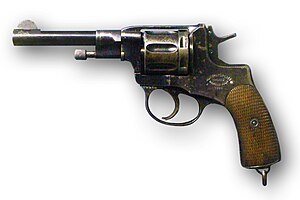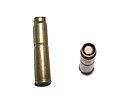Nagant M1895
| Nagant M1895 | |
|---|---|

|
|
| general information | |
| Civil name: | Nagant revolver |
| Military designation: | 7.62mm Nagan Revolver, Model 1895/56-N-121 |
| Country of operation: | Russia , Soviet Union |
| Developer / Manufacturer: | Fabrique d'Armes Em. & L. Nagant , Liège Ischmasch , Ischewsk Tulski Oruscheiny Sawod (TOS), Tula |
| Manufacturer country: | Belgium , Russia, Soviet Union |
| Production time: | 1895 to 1945 |
| Weapon Category: | revolver |
| Furnishing | |
| Overall length: | 235 mm |
| Total height: | 140 mm |
| Weight: (unloaded) | 0.79 kg |
| Barrel length : | 114 mm |
| Technical specifications | |
| Caliber : | 7.62 × 38 mm rows |
| Possible magazine fillings : | 7 cartridges |
| Ammunition supply : | drum |
| Cadence : | 14 rounds / min |
| Fire types: | Single fire |
| Number of trains : | 4th |
| Twist : | right |
| Visor : | Rear sight and front sight |
| Lists on the subject | |
The Nagant M1895 is a seven-shot revolver developed in Belgium by Henri-Léon Nagant , which was particularly popular in the Russian Empire and later in the Soviet Union . Since the 't' in Nagant is mute, the revolver is called Наган (Nagan) in Russian . The military designation is 7.62 mm Nagan revolver, model 1895, the GRAU index 56-N-121 ( Russian: 7.62-мм револьвер Нагана обр. 1895 г., индекс ГРАУ 56-Н-121 ).
The turret uses specially developed for him Nagant cartridge in caliber 7.62 mm.
history
The weapon, which was originally manufactured in Liège in the “Fabrique d'Armes Émile & Léon Nagant”, soon found sales in other countries. Sweden, later also France and Poland bought revolvers from Liege. In 1895, the Russian Empire then adopted the model as an official service or orderly weapon for the police and the military. The fact that the type was preferred was more likely due to Léon Nagant's good relations with the court of Tsar Nicholas , because the Nagant revolver was actually no longer technically state-of-the-art when it was introduced its manufacture.
technology
The Nagant M1895 is a closed-frame SA / DA turret with a caliber of 7.62 mm. Its drum holds 7 rounds and cannot be unfolded. For loading and unloading, a loading flap must be opened behind the drum on the right-hand side, through which the cartridges are ejected or loaded chamber by chamber.
The mechanism of the Nagant revolver has a special feature that sets it apart from many other revolvers. When the weapon is fired, the gap between the barrel and the barrel attachment is closed; it is gas-tight. With the Nagant, pulling the trigger not only causes the drum to rotate to the next chamber, but also presses the drum against the base of the barrel before the shot breaks. The case mouth of the cartridge, which protrudes above the drum, is pressed into the barrel. This creates a loosening between the barrel and the barrel when the shot is fired . This requires special ammunition in which the projectile sits completely inside the longer than usual case. Advancing the drum increases the pull-off resistance.
The Nagant was originally a pure double-action revolver. At the request of the Russian army command, a single-action version was constructed, which was issued to teams. The double-action version was reserved for officers and police officers. The pull-off resistance of the DA version could exceed 10 kg and was therefore extremely high.
The special technology of the revolver had one advantage: in contrast to other weapons of this type, it could be effectively silenced. Revolvers usually have a drum gap of 0.1 to 0.2 millimeters, through which a small part of the propellant gases escape and cause popping noises. In addition, the floor must not exceed when incinerating the speed of sound, because this is the sonic boom heard. Neither was the case with the Nagant, because the muzzle velocity did not exceed 280 m / s. Accordingly, some copies were equipped with silencers of the "Bramit" type (after the developers Mitin brothers ( Russian: Братья Митины Bratja Mitin) ) and u. a. issued to special commands of the NKVD .
commitment
After the October Revolution , Nagant revolvers were adopted as handguns by the Red Army . Production stopped shortly before the start of the Second World War, but was accelerated again after the attack by the Wehrmacht . If the nagant was out of date when it was taken over into the armory of the tsarist army , it was now an anachronism. The TT-33 pistol, a modern self-loading pistol, had been available to the Soviet armed forces since the 1930s . Nonetheless, the weapon was popular with the soldiers at the front, which was mainly due to its resilience. When the war ended, production was finally stopped; the weapon remained in service with guards and factory security units of the USSR until the early 1980s.
Trivia
The weapon type is mentioned as Nagan in the partisan songs Zog nishṭ ḳeynmol and Shtil, di nakht iz oysgeshternt , both by Hirsch Glik .
literature
- Regulations for the use of the M1895 revolver and the M1930 pistol . Wojennisdat, 1940, p. 7–59 ( forgottenweapons.com [PDF; 20.0 MB ] Russian: Наставление по стрелкому делу (НСД-38) * револвер обр. 1895 г. и пистолет обр. 1930 г. ).
Individual evidence
- ↑ "Bramit" sound suppressor - notes of soviet armorer. In: sovietarmorer.wordpress.com. Retrieved September 18, 2017 (English).
- ↑ Bill Harriman: The Mosin-Nagant Rifle . Bloomsbury Publishing, 2016, ISBN 978-1-4728-1416-6 , pp. 57 ( limited preview in Google Book search).
- ↑ Maxim Popenker: Nagant m.1895. In: Modern Firearms. modernfirearms.net, accessed September 18, 2017 .
Web links
- M1895 Nagant. In: forgottenweapons.com. Retrieved September 18, 2017 (English).
- M1895 Nagant Followup: Manuals. In: forgottenweapons.com. Retrieved September 18, 2017 .


